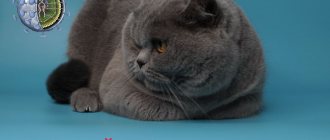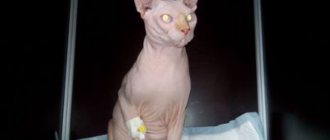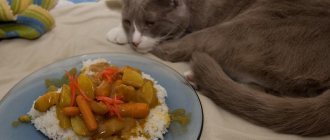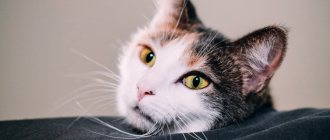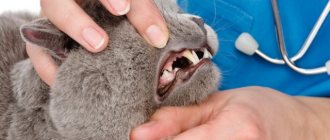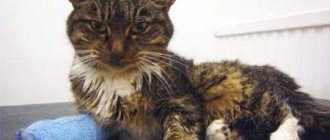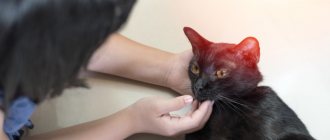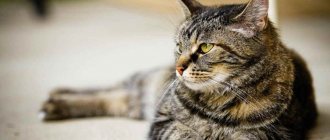The most common diseases
If a cat suffers from discomfort, the owner also feels it, because the once affectionate and playful pet demonstrates apathetic behavior, eats poorly, and loses interest in what is happening. In such situations, the following pathologies may appear:
Ingrown claws
In order for the claws to be naturally cleared of the old stratum corneum and to always be of optimal length and shape, the animal needs to constantly scratch something, climb trees, and walk on hard surfaces. However, in home conditions, fulfilling these requirements is impossible or difficult. Representatives of the cat family, especially representatives of inactive large breeds, cannot sharpen their claws and become members of the risk group.
Prevention and treatment measures consist of the following: In the room where the furry family pet lives, you need to install a scratching post. There is a huge selection of models on sale in wall, floor and combined formats. If an ingrown claw is detected by the characteristic focus of inflammation that appears on the paw, you must immediately begin drug therapy and remove the excess length of the claw with a special device. Otherwise, the dirt accumulated in the wound will lead to the formation of pus, and the condition will worsen every day - discomfort and severe pain will appear in the affected area.
Cracks on the pads
After mechanical damage and injury, cracks form on the pads and the claws break off. Then purulent inflammation begins in the corolla, and over time the claw falls off on its own.
If this does not happen, surgery is required. The veterinarian will cut away the affected tissue, apply sutures, and cover the affected area with a sterile bandage. Simple actions can help minimize risk. It is important to avoid making the claws too sharp and long, and if they are damaged, wash the paws in a solution with an antiseptic effect, which will remove bacteria and relieve inflammation.
Foreign body entry
If your pet constantly limps, hides its paw under its body and licks it for a long time, you can suspect that a foreign body has entered the tissue. A foreign object not only causes pain and inconvenience, but also increases the likelihood of serious infections being introduced into the body.
The foreign body must be removed without delaying the time of seeking help from a specialized veterinary clinic. If treatment is not started, the inflammatory process increases, the virus penetrates the subcutaneous tissue, affects tendons and joints, causing such terrible consequences as amputation of a limb. When you notice the first signs of an illness, you need to make an appointment with a specialist who will perform an examination in the office, prescribe an x-ray or other types of diagnostics and studies.
Inflammation of the corolla
After severe bruises, wounds and blows in different parts of the front and hind legs, the corolla becomes inflamed. The disease also appears against the background of the consequences of previous infectious processes. If the condition is advanced, a procedure for extirpation of the claws and sometimes the phalanges of the fingers is required. After it, the cat will limp, but will be able to live its previous life and remain physically active.
Treatment of mild cases of inflammation of the corolla involves other directions:
- warm baths with antiseptic drugs
- applying dressings soaked in disinfectants
- medicines
To recognize a problem, you need to know exactly the nature of its manifestations. The most pronounced symptoms are staggering and rejection of the claws, loss of their shine and rigidity, pain and swelling of the fingers.
Pododermatitis
The most common reason for a visit to a veterinary clinic is inflammation of the soft tissues on the pet’s paws. The disease is called pododermatitis, and is manifested by the following symptoms:
- the gait becomes uncertain and shaky, steps are difficult
- pain and discomfort bother you when moving
- visually the pads appear swollen and inflamed, they may have ulcers and cracks
Due to unpleasant sensations, the cat begins to exhibit aggressive behavior that is unusual for it, it develops nervousness, and its stress level rises daily. To help the animal, it is important to sound the alarm in the first stages of disease progression and not ignore the above symptoms. If you miss a critical moment, you may encounter irreversible changes.
Pododermatitis appears under the influence of various negative factors:
A. Hypothermia
If your pet sleeps in a draft, walks in inclement weather, or after bathing enters a room without heating, there is a high risk of hypothermia.
B. Exposure to chemical environment
In the off-season and winter, pedestrian paths and driveways are sprinkled with chemicals that prevent the surface from freezing. If a cat walks along such routes, aggressive substances fall on the paws, penetrate the skin and irritate it, triggering necrotic processes in the tissue structure.
B. Allergic reactions
Allergens have an adverse effect on health and well-being. They cause dermatitis, and cats with a low immune response in the body cannot resist the disease.
D. Pathogenic bacterial infection
The bacterial environment enters the body through various skin injuries - cuts, wounds, abrasions. The result is the appearance of a fungal disease on the paws, which becomes chronic without treatment. With mycoses, the skin flakes and itches, and the cat makes attempts to shake off its paws. Due to severe, irrepressible itching, extensive wound surfaces appear, and the pet becomes restless and irritated.
D. Autoimmune diseases
Pododermatitis can be a consequence of past autoimmune diseases. It progresses in young and adult cats, but cats with excess body weight, as well as weakened pets with an incorrectly structured diet and a passive lifestyle, are most susceptible to the disease.
Owners can find out that the soft tissues on their paws are inflamed by the following signs:
- the cat spends more time on hygiene - constantly licks its paws
- the pads feel unusually soft to the touch, lose their elasticity and shape
- specks of blood appear on the surface of the integument
If these symptoms are missed, necrosis may develop on the paws, which is accompanied by sepsis. In advanced cases, even the most experienced and professional veterinarians do not guarantee a high probability of the cat’s survival, because the methods known in medicine are ineffective in severe conditions.
Symptoms of dry skin in cats
The most obvious sign of a dry skin problem in cats is the presence of many small white flakes, similar to dandruff, that stand out on the cat's fur, causing severe itching in areas of the body where they are most numerous. In addition, cats with dry, dehydrated skin often have dull coats.
Other symptoms include the aforementioned itching, which in turn causes the cat to become over-cleaning and obsessively lick itself. The brushing and rubbing caused by constant scratching can eventually increase hair loss, which can lead to true hairless patches appearing on the cat's body.
© shutterstock
How to prevent pathologies and maintain health?
Caring owners know that the best solution is to carry out preventive measures on an ongoing basis. They include performing the following rituals:
- daily visual inspection of the paws for damage and inflammation
- routine visits to the veterinary clinic
- treating paws with antiseptics to prevent fungi and bacteria from entering the tissues
With timely initiation of treatment, which involves antibiotic therapy, the animal’s condition can be alleviated and, over time, the furry pet’s lost quality of life can be completely restored.
Hygiene procedures
It will also be necessary to master a number of hygiene procedures that are aimed at reducing the risk of pododermatitis. Among them:
- regular use of protective ointments and creams
- washing paws with soapy solutions after walking outdoors
- trimming claws with your own hands using a nail clipper or in a grooming salon
It is important to understand the fact that the disease is very insidious and dangerous. It is much easier to prevent it than to cure it, and then look for ways to eliminate its many unpleasant consequences. If the owner monitors the condition of the animal, he will protect him from risk and provide reliable health protection.
If your cat has cracked paw pads
The causes of cracked paw pads in cats can be very diverse.
Here are the most common:
- lack of vitamins (avitaminosis) and other substances necessary for the body (in particular biotin, vitamins A, B1, B2, B3, B6);
- metabolic disorders (blood biochemistry will help determine the cause);
- fungal skin diseases;
- liver problems ;
- stress;
- excessive dry air ;
- parquet in the apartment;
- poorly flushed cleaning products ;
- incorrectly selected pet shampoo (if you wash your cat frequently);
- cat litter (often cement or clay litters are very drying to cats' paw pads. In addition, cement dust from these litters can cause upper respiratory tract diseases).
And so, having established the cause, you can solve the problem. Show your cat to a veterinarian, take a blood test for biochemistry, make sure there is no fungus or other health problems. Balance your cat's diet and add essential vitamins. Please note that vitamin A is a fat-soluble vitamin, so when giving it, add half a teaspoon of olive oil to your cat's diet. Vitamin B and biotin are found in raw egg yolk. But it is not digested if it is eaten together with raw protein, so give your cat only raw yolk 2 times a week (this is also good for the coat and skin). If the reason is stress, try to level it out, knowing the characteristics of the cat and what could cause stress. Finally, use Feliway. If the problem is excessive dry air, purchase a steam humidifier or place a container of water near the central heating radiators. This will be useful not only for the cat, but also for you and your indoor plants. If the problem is cat litter, replace the clay or cement clumping litter with silica gel. And the best thing is sawdust. Wood filler is environmentally friendly, perfectly absorbs moisture and odors, smells pleasant of wood, does not dry out paws, does not cause allergies, and most importantly, it can be flushed down the toilet.
What to do with cracks that have already appeared on the paw pads?
If the paw pads are dry and begin to crack, it is necessary to regularly lubricate:
- baby cream (preferably odorless) or Vaseline, or any other ointment based on Vaseline or lanolin;
- the best way is to lubricate with sea buckthorn oil (the cat will have to be held in your arms for some time so that the cream or oil is absorbed, about 20-30 minutes, the course of treatment is 7-10 days 3-4 times a day until it disappears completely);
- can also be greased with butter;
- if the cracks are caused by vitamin deficiency RADEVIT vitamin ointment or an oil solution of retinol (vitamin A);
- You can also use gel for paws of dogs and cats, hygienic balm Vedinol or wound-healing veterinary drug Ranosan.
In any case, temporary measures to alleviate the animal's condition are described here. You should not self-medicate. Don’t be lazy, consult with your veterinarian to rule out serious medical causes such as metabolic disorders, liver problems, fungus, etc.
The article was prepared by the Helen Empire ; use on other resources without our consent is prohibited in accordance with the Civil Code of the Russian Federation.
Terms of use of materials from the Helen Empire website - obligatory link to us!!!
